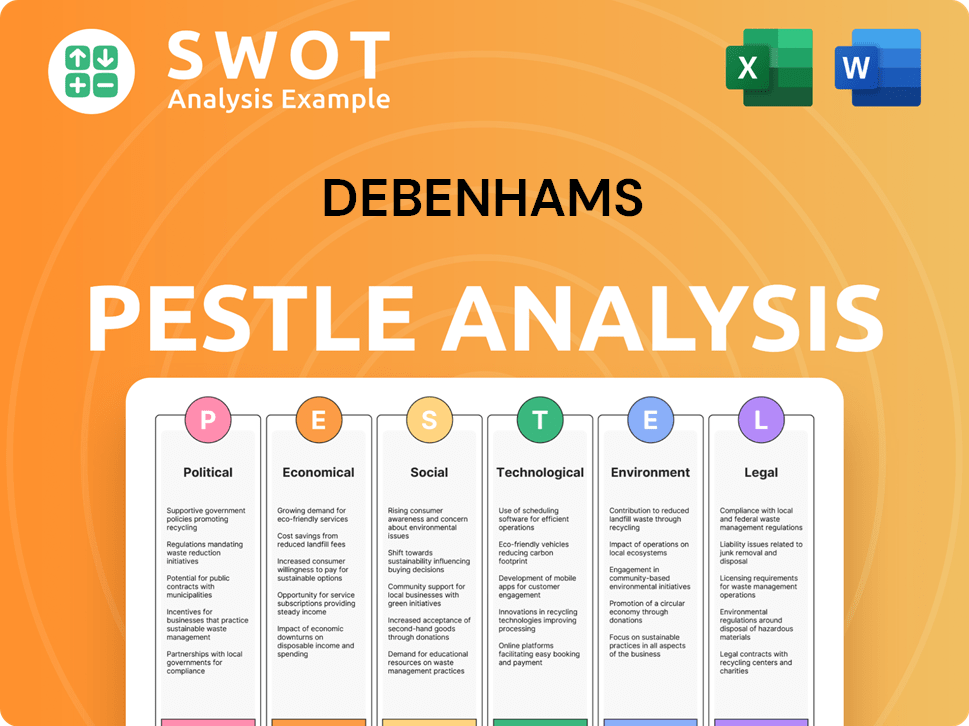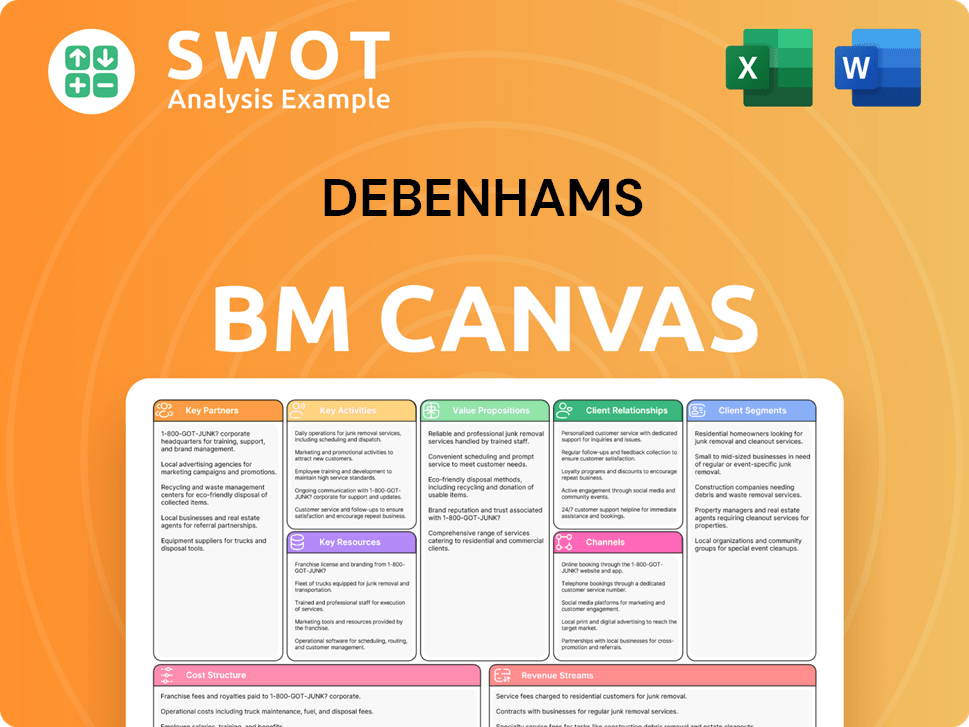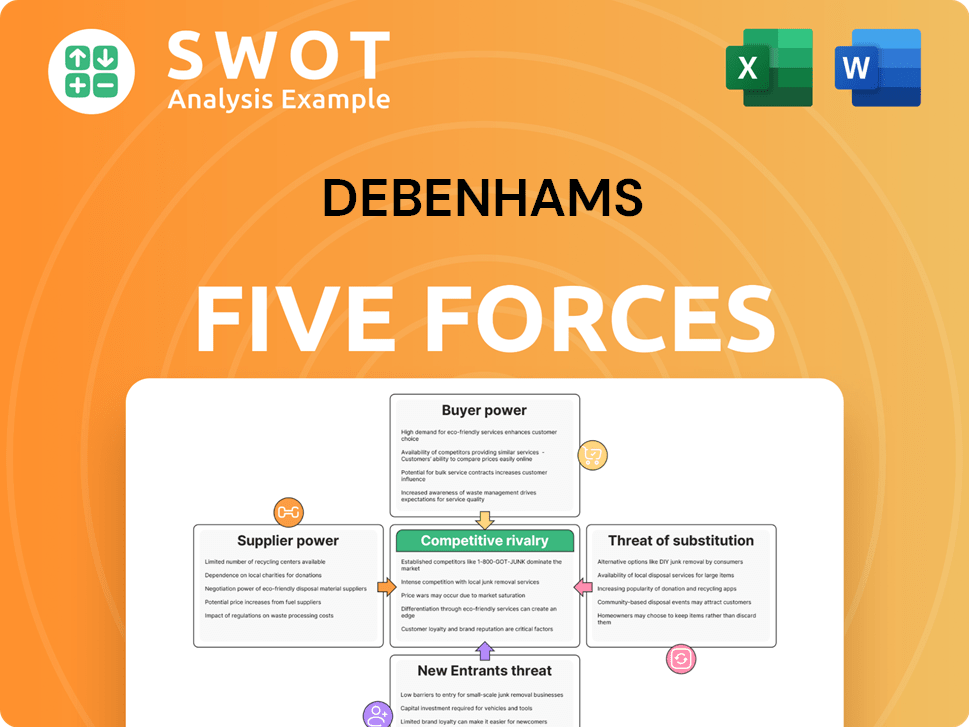Debenhams Bundle
Can Debenhams Thrive in Today's Retail Battleground?
The UK retail sector is a battlefield, constantly reshaped by online giants and shifting consumer tastes. Debenhams, a historic name, is undergoing a dramatic transformation under the Boohoo Group, rebranding in March 2025. This strategic pivot begs the question: can Debenhams successfully navigate this complex Debenhams SWOT Analysis and reclaim its place in the market?

This analysis dives deep into the Debenhams competitive landscape, exploring its key rivals and the strategies it employs to stay relevant. We'll conduct a thorough Debenhams market analysis, examining the impact of online retailers and the company's evolving brand positioning. Understanding the Debenhams competitors and their market share is crucial to evaluating its chances of success in the UK retail market, and this report provides actionable insights for investors and strategists alike.
Where Does Debenhams’ Stand in the Current Market?
The Debenhams Group, formerly Boohoo Group, has established a strong market position in the UK retail industry. Following its acquisition in 2021, Debenhams transformed into a digital marketplace, focusing on fashion, beauty, and home goods. This strategic shift has allowed the brand to leverage a capital-light, low-risk operating model, enhancing its market competitiveness.
Debenhams serves a diverse customer base by offering a wide range of products, positioning itself as a one-stop shop for consumers. The company's multi-channel approach, combining its historical brand recognition with an expanded online platform, enables it to reach a wider audience. The rebranding to Debenhams Group in March 2025 underscores the importance of the Debenhams brand and its marketplace model in the group's future strategy.
The online marketplace has emerged as a significant asset, reporting a 10% year-over-year sales increase and maintaining healthy EBITDA margins of 12%, with expectations to reach 20% in the medium term. As of March 2025, Debenhams has onboarded approximately 10,000 brands to its platform, and its gross merchandise value (GMV) reached £654 million in the full year to February 2025, up from £489 million the previous year. The company aims for a multi-billion pound GMV in the medium term. For more insights, you can read a Brief History of Debenhams.
Debenhams focuses on fashion, beauty, and home goods, catering to a broad customer base. This focus allows Debenhams to offer a comprehensive product range. The brand's strategy is centered around a digital marketplace model.
Debenhams has shown strong financial performance with a 10% year-over-year sales increase. The company maintains healthy EBITDA margins of 12%, with plans to reach 20% in the medium term. GMV reached £654 million in the full year to February 2025.
The company has a multi-channel approach, combining its brand recognition with an expanded online platform. Debenhams onboarded approximately 10,000 brands to its platform as of March 2025. This strategy allows Debenhams to reach a wider audience.
Debenhams aims for a multi-billion pound GMV in the medium term. The rebranding to Debenhams Group highlights the importance of the brand in the group's future strategy. The company is focused on growth and expansion within the retail sector.
Debenhams' key strengths include its strong brand recognition and a well-established digital marketplace. The company benefits from a capital-light, low-risk operating model. The multi-channel approach allows for a wider reach and a seamless shopping experience.
- Strong brand recognition
- Established digital marketplace
- Capital-light, low-risk operating model
- Multi-channel approach
Debenhams SWOT Analysis
- Complete SWOT Breakdown
- Fully Customizable
- Editable in Excel & Word
- Professional Formatting
- Investor-Ready Format

Who Are the Main Competitors Challenging Debenhams?
The Marketing Strategy of Debenhams highlights the company's struggle in a rapidly evolving retail environment. Understanding the Debenhams competitive landscape is crucial for assessing its position within the UK retail market. This analysis focuses on identifying Debenhams' main rivals and evaluating their impact.
Debenhams' competitive environment is complex, encompassing both traditional department stores and online retailers. The company faces pressure from various fronts, including established brands and fast-fashion giants. A thorough Debenhams market analysis reveals the challenges and opportunities in the current retail landscape.
The retail industry analysis shows that Debenhams' ability to compete depends on its strategic responses to changing consumer behaviors and market trends. Examining Debenhams' financial performance versus competitors provides insights into its current position and future prospects.
Key direct competitors include established brick-and-mortar retailers with strong online presences. These competitors offer similar product ranges and target demographics. Understanding these players is essential for evaluating Debenhams' competitive strategies.
A significant competitor in clothing, beauty, and food. Marks & Spencer's financial performance offers a benchmark for Debenhams. As of March 2025, Marks & Spencer reported a 3.5% increase in Fashion, Home & Beauty sales, with like-for-like sales up 4.4%, and an adjusted operating profit margin of 11.2% in this segment.
Another major department store rival. John Lewis's recent financial results provide insights into the department store competition. For the full year 2024/25, John Lewis tripled its profit before tax and exceptional items from £42 million to £126 million, with sales up 3% year-on-year to £12.8 billion.
Offers a similar product range to Debenhams. House of Fraser's market position also influences the overall competitive landscape. The competitive strategies of Debenhams need to consider the performance of House of Fraser.
Indirect competitors include online retailers, particularly those specializing in fast fashion. These companies offer lower prices and faster production cycles, impacting Debenhams' market share. The impact of online retailers on Debenhams is significant.
Fast-fashion online retailers that pose a significant competitive threat. These companies' business models and pricing strategies create intense competition. The rise of these retailers has changed the Debenhams' current competitive environment.
Debenhams' strategies to compete with online stores include leveraging its established brand recognition and marketplace model. The rebranding of Boohoo Group to Debenhams Group in March 2025 is a strategic move. Understanding Debenhams' key strengths and weaknesses is crucial for evaluating its future in the retail sector.
- Boohoo Group: The youth-oriented labels (Boohoo, PrettyLittleThing, and BoohooMAN) experienced a 21% decline in sales.
- Next: Also competes in the fashion and home categories, adding to the competitive pressure.
- Debenhams' Online Marketplace: Saw a 10% sales increase in the recent fiscal year.
- Brand Recognition: Debenhams' established brand recognition is a key asset in the crowded online retail market.
Debenhams PESTLE Analysis
- Covers All 6 PESTLE Categories
- No Research Needed – Save Hours of Work
- Built by Experts, Trusted by Consultants
- Instant Download, Ready to Use
- 100% Editable, Fully Customizable

What Gives Debenhams a Competitive Edge Over Its Rivals?
The new Debenhams Group, post-acquisition, has undergone a significant transformation, shifting from a traditional department store model to a digital marketplace. This strategic pivot has allowed it to leverage its brand recognition and heritage while adapting to the evolving retail industry. This shift is evident in its focus on online sales and strategic partnerships, reshaping its competitive advantages in the UK retail market.
Key to its new strategy is a focus on a multi-channel presence, primarily through its online platform. This move has enabled Debenhams to reach a wider audience and offer a seamless shopping experience. The company's strategy is centered on a capital-light, low-risk model, which has proven to be profitable and cash-generative, driving its competitive edge.
Debenhams' competitive landscape has changed dramatically, with a focus on online retail and strategic partnerships. This evolution is aimed at sustainable growth in the retail sector, leveraging its brand recognition and heritage. The company aims to offer a diverse range of products through its online marketplace, ensuring a strong position in the UK retail market.
Debenhams benefits from strong brand recognition built over centuries, attracting a loyal customer base. This heritage is associated with quality products across various categories, including women's clothing, menswear, beauty, kids, and homeware. This established brand reputation is a key factor in its competitive strategy, helping it stand out in a crowded market.
The transition to a robust online platform has provided a seamless shopping experience, reaching a wider audience. This digital marketplace model, implemented post-acquisition, is capital-light and low-risk. This strategy allows Debenhams to adapt to changing consumer behaviors and compete effectively in the online retail space.
Debenhams establishes exclusive partnerships with renowned brands and designers, offering unique and premium products. The ability to onboard approximately 10,000 brands by late 2024 demonstrates its capacity to offer extensive variety and cater to diverse consumer needs. This approach helps differentiate Debenhams from its competitors.
Debenhams focuses on innovation and staying ahead of trends, coupled with investments in technology to enhance the online shopping experience. This includes improving user experience, personalization, and efficient logistics. This investment helps Debenhams maintain a competitive edge in the rapidly evolving retail industry.
Debenhams' competitive advantages include strong brand recognition, a robust online platform, strategic partnerships, and a focus on innovation. These elements have enabled the company to adapt to the changing retail landscape. The company's financial performance reflects this success, with the online marketplace reporting a 10% year-over-year sales increase and healthy EBITDA margins of 12%, with a medium-term target of 20%.
- Strong brand recognition and heritage.
- Multi-channel presence with a focus on online sales.
- Strategic partnerships with leading brands.
- Investments in technology and innovation.
Debenhams Business Model Canvas
- Complete 9-Block Business Model Canvas
- Effortlessly Communicate Your Business Strategy
- Investor-Ready BMC Format
- 100% Editable and Customizable
- Clear and Structured Layout

What Industry Trends Are Reshaping Debenhams’s Competitive Landscape?
The retail industry is in constant flux, and the Debenhams competitive landscape is significantly impacted by these changes. The company faces both challenges and opportunities as it navigates this dynamic environment. Understanding the current market trends, potential future hurdles, and growth prospects is crucial for Debenhams to maintain its market position and achieve long-term success. The company is undergoing a strategic pivot to adapt to these shifts.
This analysis provides insights into the Debenhams market analysis, focusing on industry trends, future challenges, and potential opportunities. It covers the impact of e-commerce, changing consumer preferences, and the competitive pressures within the UK retail market. The goal is to provide a comprehensive overview of the factors shaping Debenhams' future, including its strategies to compete with online stores and its potential for growth.
The retail industry is undergoing a significant transformation. E-commerce continues to grow, with online sales in the UK accounting for 26.3% of total retail sales in March 2025, up from 25.8% in March 2024. Consumer preferences are also evolving, with a rising demand for sustainable products and a shift towards resale commerce. Social commerce is another emerging trend.
Debenhams faces intense competition from both traditional retailers and fast-fashion players. Economic uncertainty impacting consumer spending poses a challenge. Increased business rates in the UK for 2024-2025 could also hinder profitability. The youth brands under the Debenhams Group experienced a 21% sales decline due to fierce competition.
Significant opportunities exist for Debenhams, including international expansion and digital transformation. Strategic partnerships and diversification of product offerings are also key growth areas. Enhancing the customer experience and leveraging innovative technologies are crucial for attracting new customers. The company aims for a 20% EBITDA margin and approximately £150 million in annual cost savings.
Debenhams is focusing on a marketplace model to drive growth. Operational efficiency and cost savings are central to the company's strategy. The company is leveraging its parent company's experience for potential international expansion. These initiatives are designed to improve Debenhams' market position and ensure long-term viability.
Debenhams' competitive strategies involve adapting to e-commerce growth and changing consumer preferences. These include investing in online platforms, digital marketing, and focusing on sustainable products. Strategic partnerships and international expansion are also key.
- Embracing E-commerce: Investing in online platforms and digital marketing to provide a seamless shopping experience.
- Adapting to Consumer Preferences: Focusing on eco-friendly materials and ethical sourcing.
- Strategic Partnerships: Leveraging partnerships for expansion and product diversification.
- Operational Efficiency: Focusing on cost savings and improving overall operational performance.
Debenhams Porter's Five Forces Analysis
- Covers All 5 Competitive Forces in Detail
- Structured for Consultants, Students, and Founders
- 100% Editable in Microsoft Word & Excel
- Instant Digital Download – Use Immediately
- Compatible with Mac & PC – Fully Unlocked

Related Blogs
- What are Mission Vision & Core Values of Debenhams Company?
- What is Growth Strategy and Future Prospects of Debenhams Company?
- How Does Debenhams Company Work?
- What is Sales and Marketing Strategy of Debenhams Company?
- What is Brief History of Debenhams Company?
- Who Owns Debenhams Company?
- What is Customer Demographics and Target Market of Debenhams Company?
Disclaimer
All information, articles, and product details provided on this website are for general informational and educational purposes only. We do not claim any ownership over, nor do we intend to infringe upon, any trademarks, copyrights, logos, brand names, or other intellectual property mentioned or depicted on this site. Such intellectual property remains the property of its respective owners, and any references here are made solely for identification or informational purposes, without implying any affiliation, endorsement, or partnership.
We make no representations or warranties, express or implied, regarding the accuracy, completeness, or suitability of any content or products presented. Nothing on this website should be construed as legal, tax, investment, financial, medical, or other professional advice. In addition, no part of this site—including articles or product references—constitutes a solicitation, recommendation, endorsement, advertisement, or offer to buy or sell any securities, franchises, or other financial instruments, particularly in jurisdictions where such activity would be unlawful.
All content is of a general nature and may not address the specific circumstances of any individual or entity. It is not a substitute for professional advice or services. Any actions you take based on the information provided here are strictly at your own risk. You accept full responsibility for any decisions or outcomes arising from your use of this website and agree to release us from any liability in connection with your use of, or reliance upon, the content or products found herein.